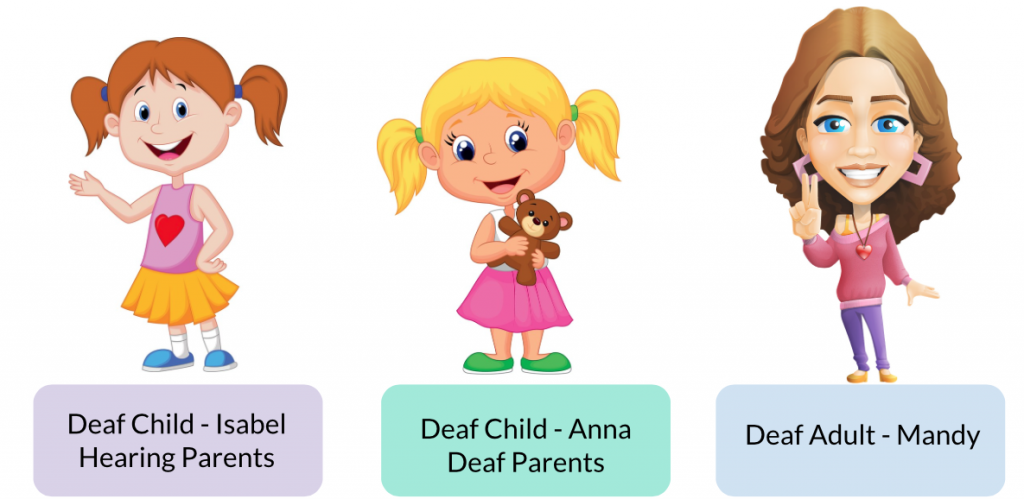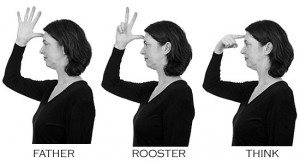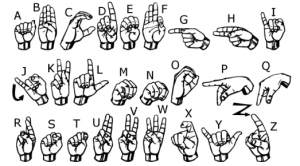Contents
Overview
Before we get started, please take a moment to enjoy this heartwarming video that illustrates the life of a deaf family!
Next, here are three sentences we got from literatures to give you an idea of our topic:
“The hearing loss itself acts as a drastic filter on the linguistic data, and information obtained from aided residual hearing… is typically fragmentary” (1).
“Although the deaf children were well-integrated into their families, they were obviously limited in their access to learning opportunities that a conventional language affords” (2).
“Because there is no language barrier between deaf mothers and their deaf children, deaf mothers will “intuitively adjust their linguistic and cultural practices to the needs of their young children” (3).
From these sentences, you can probably understand certain issues faced by the deaf community. What our topic plans to do is to take you on a journey together with this special group of people, in hope that you can learn a valuable lesson from our content 🙂
Here at this WikiChapter, we introduce three of our lead characters to you! They are Isabel, Anna and Mandy. All three of them are a part of the deaf community; Isabel and Anna are deaf children while Mandy is a deaf adult. Isabel is born to hearing parents and Anna, to deaf parents. Following the upcoming topics, all three of them will be there to guide you by illustrating scenarios for your better understanding of our WikiChapter.

Introduction
Have you ever wondered how it feels like to be in a world of silence? This is what the deaf community goes through every single day. Given the prevalence of deaf community across the world (4), there is a need to examine their potential in acquiring a second language for daily communication other than the usual L1 – Sign Language. Hence, our WikiChapter focuses on Spoken Language Acquisition in the form of L2 by the Deaf Community.
The key aspects include an introduction as to why this topic should be sufficiently and necessarily addressed, the differences in L2 acquisition of an in-group comparison – Deaf Community and between-group comparison – Deaf and Hearing Communities, the possible problems the Deaf Community face, some strategies we found that could mediate sign and spoken languages before concluding with our viewpoints to this topic.
Factors Affecting L2 Acquisition within Deaf Community
In this section, we focus on the factors that could possibly play a part in influencing acquisition of spoken language as L2 in the deaf community. Deaf individuals do not learn a spoken language in uniformity; there are various individual differences that would affect their L2 acquisition as a spoken language.
Age
Critical Period Hypothesis
The deaf community is affected by the critical period as well when it comes to acquiring a second language (5). It is defined as a period during someone’s development in which a particular skill or characteristic is believed to be most readily acquired. This phenomenon is particularly prominent in children because the critical period age range is believed to be from birth to about the age of five, though no definite age range has been properly attested till this date due to ethical violations should young participants be deprived of language learning in potential experiments. Research have shown that exposure to a language within the critical period enables hearing children to learn even without direct instructions. This then puts deaf children in a disadvantage as receptive access to language is absent. This can be branched out into two components;
With Cochlear Implant
Within the critical period, if Isabel and Anna successfully get a cochlear implant and gain access to some sounds, they will have increased chances to acquire a spoken language. However, researches have shown that significant advantages hold only for deaf children with cochlear implants within the first 18 months from birth as age of implantation plays a big part in determining the outcome of the target spoken language (6). Delays in hearing restoration may result in significant differences.
Without Cochlear Implant
To allow for normal speech and language development, deaf children have to be exposed to audible oral communication (7). The absence of an auditory aid may significantly cause an impact to their ultimate attainment of the target language. Cochlear implant has been proven to have a critical period as well. Deaf children who opted for the implant at a younger age have shown to do better in language performance tasks as compared to those who got it later in life.
Hence that being said, deaf adults like Mandy will definitely face a bigger challenge when it comes to acquiring a spoken language as L2. Brain plasticity changes in early childhood and deteriorates over years (8). After the critical period, her brain continually become fixed and ‘fossilized’ until a stage where any changes in linguistics environment will no longer have neurological effects. Even though the critical hypothesis theory for L2 acquisition has been constantly challenged, adequate researches have concluded that age is a crucial factor in ultimate attainment (9, 10).
Proficiency in L1 Sign Language
Cross Language Activation
The proficiency level L1 (sign language) can cause acquisition differences between deaf individuals. Spoken languages and sign language have considerable number of similarities in many areas such as usage of brain mapping to remember certain words, syntax, semantic meanings, cognates and etc. (11). This similarity can directly or indirectly impact the acquisition of a spoken language as L2 for L1 signers.
Studies conducted showed that L1 signers are capable of using their first language as an advantage to effectively learn a spoken L2 by activating signs when processing written words of a spoken language. As Fromkin (1973) mentioned, both sign and spoken languages share the same kind of mental operations (12). Hence, being proficient in one would aid another during the acquisition process, though negative transfers are possible too. Anna who is more proficient in signing due to having deaf parents, can allow more positive transfer of what is learnt in sign language to the target spoken language (13), unlike Isabel.
Example: “Shut up” in sign language – “closing the fingers and the thumb on top of your lips”
Anna can easily recognize and map the similar action between the signing form and the actual closing action of the mouth to help her learn the spoken form of “shut up”. Isabel on the other hand, will find this difficult if she has limited vocabulary in her L1. With a higher awareness of which signs are dedicated to which words and referents, Anna can take advantage of the brain-mapped icons and phonology before translating them to the target language to allow for cross-language activation (14). Thus, Anna will have a higher chance of producing better results than Isabel in the acquisition of spoken language.
Parents’ Hearing Status
Family linguistics background plays a part in affecting a child’s acquisition of a new spoken language as well. In this section, we focus primarily on the impact of having hearing and deaf parents.
Born to Hearing Parents
More than 90% of deaf children are born to hearing parents like Isabel (15). This poses a huge challenge for her to acquire sign language as many hearing parents are unaware of their child’s condition until later in life. Hearing parents have no prior knowledge of sign language. Many of them learn sign language only after realizing there is a need to in order to communicate with their child (16). Communication in the child’s first few stages of life is a barrier. As a result, sign language development is delayed as the child is not exposed to any within the critical period. This then translates to L2 acquisition issues as proficiency of L1 impacts L2 learning.
Born to Deaf Parents
Anna, on the other hand, will face lesser problems with her deaf parents. Less than 10% of deaf children are born to deaf parents like her (15). Many people have wrongly assumed that deaf children born to deaf parents will lag in language development due to the absence of oral communication. However, these children have shown to surpass those with hearing parents in terms of academic performance such as reading, writing and speaking. Deaf parents are able to make language more accessible to their child as compared to hearing parents can (17). They probably identified their hearing loss early in life and are fluent in sign language. Knowing how it is to learn a new language with auditory loss, deaf parents are naturally better communicators with their deaf children. They are capable of displaying effective and uniformed communication strategies as well as a positive attitude towards their child (18). Hence, Anna will potentially learn a spoken language as L2 better than Isabel.
Differences between Deaf and Hearing Community
Sign Language
Unlike others, Anna and Isabel use a different modality for their language. Sign language is a visual form of language that uses gestures instead of sounds. It has its own syntax and grammar just like any other spoken languages. There are five parameters in sign language, (a) handshape, (b) movement, (c) palm orientation, (d) location and (e) non-manual markers. The signs are done in the signing space, from the top of the head to the waist level (19).
The handshape refers to the configuration of your thumb and fingers.
The movement refers to the movement of your hands.
The palm orientation refers to the position and direction of your palm.
Location refers to where the sign is placed at the signing space.
Lastly, non-manual markers refer to facial expressions that are used to further express the intended message. For example, raising your eyebrows to indicate a question marker. The information conveyed could be different with different parameters used (19).
Fingerspelling refers to how letters are spelled out individually (20) and mainly used for personal names or words that they do not know the sign(s) for.
Reading Skill
Kleiman used a concurrent articulation paradigm to examine the importance of phonological coding for sentence comprehension. Phonological recoding is the inner speech – voice in our head when we read, especially during silent reading. According to the attentional resource allocation principle, one is unable to engage the articulatory apparatus and inner speech at the same time. Therefore, if the primary and secondary tasks rely on the same resources, there would be interference. For instance, by asking the participants if the sentences are semantically acceptable while reading out aloud the numbers they hear, they are strongly interfered and elicit a longer response time. This shows that phonological coding is engaged in reading comprehension (21).
However, Anna and Isabel are often labelled as ‘poor readers’ due to the lack of phonological recoding for reading comprehension. On average, their reading skills do not surpass the fourth grade. They rely on signs to decode while reading to compensate the lack of phonological coding, as they are not interfered with homophonic words or tongue twisters like hearing community do but sentences with similar signs, also known as hand twister or finger fumbler (21).
Problems deaf children faced in L2 acquisition
Sign languages are acquired similarly as spoken languages if exposed to them since birth. Anna will face lesser difficulties in L2 acquisition as compared to Isabel who is late learner of sign language (22). Proficiency in L2 for Anna and Isabel focuses on the ability to read and write but not on the auditory input and output (23). Both Anna and Isabel will encounter great difficulties in acquiring a spoken language as L2.
Input via Auditory Channel
Hearing aids like cochlear implants are only suitable for people who have severe hearing loss. They do not help to restore damaged hearing but instead, amplify speech sounds to a level of intensity above the threshold of the person’s residual hearing (1). The amplification of sound produces fragmentary auditory information that can cause great discomfort (24). Not all speech sounds are produced with equal duration, frequency and intensity. Hence, some information delivered is likely to be missing. Content words are often stressed and produced with greater intensity and come off clearer as compared to words such as inflectional morphemes, prepositions and articles. Therefore, this increases the complexity in the acquisition of morphology and syntax due to incomplete information. For Isabel who is profoundly deaf, the only information that she can hear is low-frequency vowels and consonants as well as some prosodic information (1).
Input via Lipreading
In order to lipread, Anna and Isabel have to be very focused at every movement of the lips. Speech that is out of Anna and Isabel’s vision space would not be captured. Furthermore, multiparty conversation by lipreading is particularly taxing. While trying to decipher what the speaker wants to convey, a lot of the linguistic information is not available on the lips. Many of the sounds that are visible on the lips look identical without auditory input. For example, /b/, /p/, /m/, and many vowels are confusing as well. In addition, sounds that are produced at the back of the mouth are not visible at all. Lipreading is closely correlated to language proficiency and degree of hearing loss. Therefore, it is impossible for Isabel to comprehend much information via lipreading as she is profoundly deaf and does not have a good grasp of sign language (1).
Input via a Signed Code for English
It is not easy for Anna and Isabel to achieve a complete mapping of English sentences into signs and vice versa (1) as sign language does not sign word-for-word, unlike English. Signers often omit function words, grammatical morphemes and etc., focusing more on content words as they are perceived to be more essential to the message and generally easier to learn. A single gesture or sign could be used to express the entire meaning of the sentence. In fact, the movement of limbs’ gestures are not as fast as vocal apparatus. When every single morpheme in a spoken language has to be signed, multiple signs would be used. This results in a lengthy sequence of hand movements that exceed human short-term memory and processing abilities. The efficiency of signing is inverse with the structure of English; an increase in the former would reflect a decrease in the latter (25). Thus, either way of mapping would cause great difficulties in acquiring the syntax and morphology of a spoken language (1).
Input via Print
Comprehension is often absorbed through shared context and gestures accompanying speech during conversations. However, none of such information is available from the printed text. On the contrary, meanings must be derived from the words alone along with the syntactic and semantic analysis, which Anna and Isabel do not process. Other information such as intonation and stress pattern that may help the child to perform syntactic analysis are not provided, unless where constituent boundaries occur are signaled (1). Last but not least, the purpose to learn a language is to communicate. However, learning via print does not provide such social interaction function (25).
Strategies to Aid Deaf Children in Picking Up a Spoken Language
Isabel’s mother has been facing difficulties trying to teach her deaf daughter English as a second language as she is unable to make Isabel understand the workings and concepts of it. Despite her consistent efforts, Isabel is still unable to read or write fluently in English. Anna’s mother reassures Isabel’s mother that such happenings are common in hearing parents since they are unable to intuitively understand the difficulties their deaf child face (26). On the other hand, Anna’s mother who is also deaf herself, knows what her child needs in order to learn a spoken language. Anna’s mother advises that the key in aiding a deaf child to learn a spoken language as a L2 is to make connections between the sign language and the spoken language (26), which can be done so with several strategies.
Chaining
When reading to young Anna, her mother adopts the chaining technique which allows Anna to better understand English words and texts. Chaining is done by first fingerspelling a word to the learner, followed by showing her the written form of the word and then the signed form of the word, sometimes with pictorial support (28).
Providing English Definitions
Anna’s mother also makes the constant effort to provide definitions for new words that Anna encounter. Since deaf children usually fall short in their vocabulary as compared to hearing children (27), this action is of significant importance as it would be of additional help to make words explicit to them.
Interpreting English Word Sounds
Isabel’s mother has never knew that Isabel will have difficulties with onomatopoeic words since, to herself, the semantics of these words are straightforward and obvious. However, Anna’s mother understands that her daughter will not instinctively know what these sounds represent and hence recognizes the need to provide her with definitions of these words. Explaining to a deaf child the word ‘zoom’ is a sound caused by a fast moving object will allow for better comprehension when the child encounters other sentences containing this word, such as, ‘He drove away with a zoom’ (28).
Explaining the Difference of Similar-Looking English Words
Isabel’s mother never thought of making explicit distinctions between two similar-looking words to Isabel since to her, these words have obvious dissimilarities due to the differences in their sounds. However, emphasizing on how a change in a letter can lead to an entirely different word and meaning will allow deaf children to take note of the spellings of different words. Also, providing the accurate spellings and semantics of visually similar words can benefit deaf children in their learning journey to read and write (28).
Explaining Rhyming in English
Rhyming of words may not seem to be an important knowledge for deaf children since they will not be exposed to the sound of words. However, Anna’s mother still makes the effort to pick out rhyming words and explain to Anna how their similar spellings make them sound alike. Unlike Isabel’s mother, Anna’s mother understands that knowledge of such information will allow her deaf daughter to develop an understanding of the language and encourages possible articulation of words (28).
Explaining Font Sizes
It seems intuitive for hearing people to read large words in a text with greater emphasis and volume and vice versa. However, this is not as instinctive for deaf children without inner speech (28). With such understanding, Anna’s mother makes sure to allow Anna to understand how different font sizes convey different messages. For instance, she uses signs and facial expressions to show Anna how the capitalized text in a book indicates that the character is screaming angrily.
Explaining Different Sign Meanings for Each Word
Like Isabel’s mother, many hearing parents do not realize that not every word in spoken languages have equivalent connotations in sign languages. Hence, it is important to provide an explanation to their deaf children when they encounter such a word while learning a spoken language (28). For instance, for hearing people, the word “listen” is used to get someone’s auditory attention. Since deaf people are unable to provide auditory attention, their “listen” will instead be “look at me”, which is to get one’s visual attention. With that, when encountered with the word “listen”, parents should explain to their deaf child that it is equivalent to the sign “look-at-me”.
Translating into Sign Language
To ensure that Anna fully understands the meaning of the English words she sees, Anna’s mother always makes sure to translate English words to sign language (28), especially those that are new to Anna. This is important as deaf children will be able to understand the words better if they are provided with an explanation of it in their native language.
Providing Name Signs
Name signs are used in the deaf culture to address one another. Having a sign name is considered as a trademark of one’s association with the deaf culture (28). Understanding its significance, Anna’s mother allows Anna to come up with name signs for the characters in a book when she is reading to her instead of sign-spelling the names of the characters, integrating the deaf culture into the learning of a spoken language.
Signing in English Word Order
The syntax of sign languages is simpler than that of many spoken languages. For instance, there are no function words such as “is” in sign languages. The English sentence “My name is Isabel” will be signed “My name Isabel”. There is also a difference in word order between sign language and English, whereby sentences such as “Where is your bag?” will be signed as “Your bag, where?”. Hence, it is not uncommon for a deaf child to be confused by syntaxes and the usage of function words (28). To help Anna familiarize with such a different language word order, Anna’s mother would sometimes deliberately sign in English word order to teach Anna the grammatical features of the language.
Conclusion
In this society, there exists several false assumptions about the deaf community, such as the belief that deaf children with deaf parents will suffer from a developmental lag due to the absence of spoken language during their growth period. These false assumptions often lead to a stigma in the capabilities of deaf people whereby they are often thought as incompetent for many tasks. Therefore, more studies should be done in the area of the deaf community to clear such misconceptions. The deaf will definitely face more difficulties than the hearing community when learning a spoken language as an L2 due to the inaccessibility to sounds as well as the vast differences between sign languages and spoken languages. However, that does not imply that it is impossible for them to learn a spoken language since there exists mediation strategies that can help to bridge the two languages, aiding the learning of spoken language. With the right strategies used, the deaf can be as proficient in a spoken language as the hearing.







